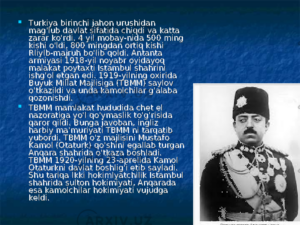SHARE WITH FRIENDS:
TURKEY in 1918-1939
PLAN :
-
World War I and Turkey.
2. Internal policy of the Republic of Turkey.
3. Foreign policy.
Turkey came out of the First World War as a defeated country and suffered great losses. During 4 years, 500 thousand people died, more than 800 thousand people were disabled. The Entente army occupied Istanbul, the capital of the country, in November 1918. At the end of 1919, elections were held for the Grand National Assembly of Turkey, and the perfectionists won.
TVMM elected Mustafa Kemal Atatürk as the head of state on April 1920, 23. In this way, two powers were established in the city of Istanbul, the power of the sultan, and the power of the governors in Ankara.
On August 1920, 10, the Entente countries signed the Treaty of Sèvres with the government of suite n. The treaty effectively ended the independent state of Turkey. On January 1921, 20, the citizens adopted the temporary Constitution of Turkey. In a difficult situation for Turkey, on March 1921, 16, the Turkmen managed to sign a friendship and brotherhood agreement with Soviet Russia and received help.
The National Liberation War ended with victory in October 1922. On November 1, the power of the sultanate was terminated. On October 1923, 29, Turkey was declared a Republic. On July 1923, 24, the Entente countries recognized the independent Republic of Turkey at the Lausanne Conference. In 1924, the caliphate was abolished.
The government of Turkey began to pursue the policy of converting foreign property into state property and investing state funds in the economy. In October 1923, the capital was moved from Istanbul to Ankara. Religion was separated from the state. Waqf property was abolished. Education was given a pure 4-university tone. Religious schools were closed. A secular court was introduced. On April 1924, 20, the first Constitution of the Republic was adopted. Secular laws were introduced. The European way of life was allowed in the constitution and laws. The Arabic alphabet was replaced by the Latin alphabet. In 1931, consumers adopted a new program. In this, the party emblem was described as 6-winged, that is, Turkey as a republican, national, people's, statist, secular, revolutionary state.
A trade agreement was signed with Italy in 1926 and with Germany in 1930. The USA also began to pay more attention to Turkey in foreign trade. In July 1932, Turkey was admitted to the League of Nations. Nazi Germany began to look at Turkey with great interest. This incident and the Italian invasion of Ethiopia forced Great Britain to change its attitude towards Turkey.
In July 1936, according to the Treaty of Montreux, the control of the straits was returned to Turkey. Great Britain began to sell large quantities of military equipment and weapons to Turkey in order to prevent the rise of German influence. During the Second World War, Turkey remained neutral.
The defeat of the German army on the outskirts of Stalingrad on February 1943, 2 did not affect Turkey's future policy. For example, in August 1944, Turkey severed diplomatic relations with Germany. At the same time, it began to get closer to the United States, Great Britain and France. This rapprochement led to the declaration of war against Germany in February 1945. However, Turkey did not participate in the war.
Control questions.
1 When was the Republic of Turkey founded?
-
Who is Kamal Ota Turk?
-
What were the limitations of Kamal Ota Turk's policy?
Basic phrases.
-
TBMM - Grand National Assembly of Turkey - legislative body.
-
The national liberation movement continued against the Treaty of Sevres in 1920-1922.
